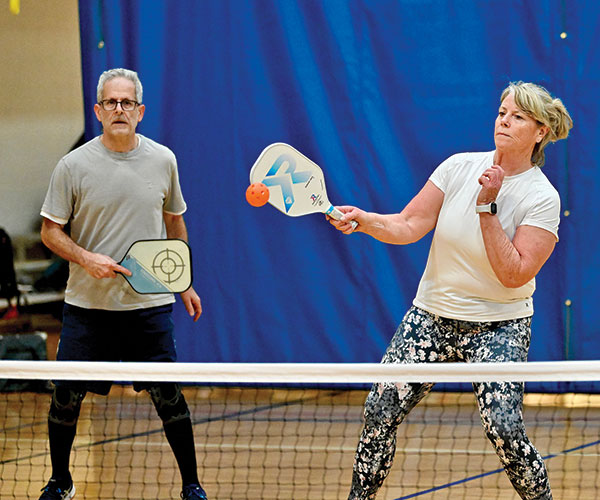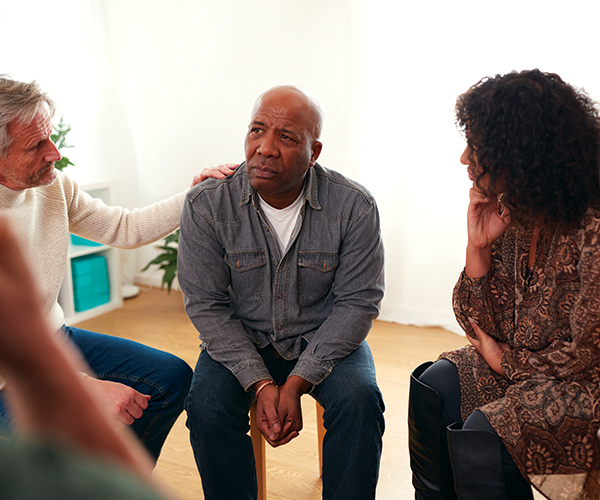The waitress at Radius, a Chagrin Falls restaurant, greets Harvey and Cindy Tucker by name.
"Good morning, Dr. Tucker, Mrs. Tucker," she says. "We have a table for you." She leads them to their seats and leaves to get them coffee and orange juice. The Tuckers make their way to the brunch buffet, but it takes them a while to get up there.
They stop at a table to talk with their neighbors. As they continue to move through the restaurant, they wave and smile at others.
They seem to know everyone.
The Tuckers return to their table with full plates — Harvey raves about the sausage, Cindy praises the bacon — and side dishes loaded with lemon cream and raspberry pastries. It looks gluttonous, until Cindy explains they're taking the pastries to a neighbor — an excuse to check on her.
assisted living to skilled nursing care.
More than 20 percent of households headed by someone 75 or older are in senior housing and care properties, according to the National Investment Center for the Senior Housing and Care Industry.
Most restaurants prohibit taking pastries out from an all-you-can-eat brunch. But Radius, though open to the public, is the dining jewel at the heart of South Franklin Circle, a continuing care retirement community in Chagrin Falls, affiliated with Judson. The employees' mission is to keep residents happy. They even send meals to residents' homes when they can't get out.
A continuing care retirement community spans all levels of retirement living, from independent toBut that's expected to change as the population of seniors grows, and seniors live longer. Americans' average life expectancy in 2010 was almost 79, an increase from about 75 years in 1990.
Each day, 10,000 baby boomers turn 65. Today, 13 percent of Americans — one in eight — are age 65 or older. Cuyahoga County's numbers are even higher, at 16 percent.
Technically, Cindy Tucker won't be a senior for two more years. She is only 63, yet she has lived at South Franklin Circle for three years. Before people got to know her, many asked if she was visiting her parents. South Franklin Circle requires just one member of a couple to be at least 55 years old. Young children can't live in the home full time, although they are welcome to visit, even for extended stays.
When South Franklin Circle was still on the drawing board, Cindy and Harvey attended a meeting about it. Harvey, 74, took aside a Judson executive. He had only one question.
"I have to tell you right now," he said, "we have three large dogs, and anywhere we go, they have to come with us." A week later, he got a phone call saying pets are not only welcome, but encouraged.
"People live longer with pets," says Cindy.
"For us, it would have been a deal breaker," says Harvey.
They moved to South Franklin Circle, even though both are still working. Harvey is an ear, nose and throat physician at MetroHealth Medical Center. Cindy is a registered nurse who works when needed at St. Vincent Charity Hospital.
They live in a cottage in the development and built their own dog run in the backyard. South Franklin Circle has a dog park and has hired a dog walking service for people who can no longer walk their pets.
Sunday brunch at Radius emphasizes the recent changes in the senior living industry. From the fresh fruit to the frittata, this is nothing like lunch at your grandma's nursing home. Gone are institutional meals — no rubber chicken or pureed peaches.
Gone, too, are rocking chairs.
Retirement living today means staying active and engaged. Above all, retirement communities help stave off social isolation.
South Franklin Circle has a pool and exercise rooms. Daily, it might host a book group or a lecture on topics from broadband technology to stem cell science.
The Weils assisted living community in Chagrin Falls holds happy hour three times a week and features chef-prepared dining. The most popular classes include yoga, tai chi and art therapy.
Breckenridge Village, a continuing care retirement community in Willoughby, has two early childhood centers on campus so seniors can interact with younger generations. In its latest effort to meet resident demands, it's even considering putting in an area where residents can build a hot rod or work on a motorcycle.
"Today, it's about, •How do we adapt to what the residents want to do in independent living?' " says David Schell, executive director at Breckenridge.
The baby boom generation is used to having choices in life, Schell says. To be successful, retirement communities will have to meet that expectation.
The average age he sees in independent living is 78 — about 13 years after retirement, when a couple wants to downsize and give up the burden of housework.
"People ask me who the competition is, and I tell them it's the person's home," Schell says. "The house holds security in one sense. But, as one ages, sometimes that security becomes a little more of a nemesis."
Cindy admits downsizing was stressful. The Tuckers gave up a 5,700-square-foot, custom-designed home for their 2,400-square-foot cottage. But giving up the work of a large home was also a motivator.
"One of the best things about this place is I don't have to change a light bulb if I don't want to," Harvey says. "I can do whatever I want to, within reason, in the house. But I don't have to."
When they travel, as they often do, the Tuckers have people nearby who can care for the house while they're away.
Heather Freemont, the vice president of sales at Judson, says that people often don't start looking for a retirement community soon enough.
"People suddenly have some kind of change or need which triggers them to begin looking," Freemont says. "They look at it as if it's only needs-driven, when really, retirement communities are driven by lifestyle."
But when people wait longer to move — until their mid-to-late 80s — they often need a higher level of care.
The next tier is assisted living, where employees help with activities of daily living, such as bathing or taking medicines.
Most assisted living and skilled nursing facilities work under a philosophy called "person-centered care." Residents can make their own decisions about when to wake up, take their medicines and eat.
A decade or so ago, the facility made those choices for the resident, getting everyone up and to breakfast by 6 a.m., scheduling baths, regimenting each aspect of every day.
Eliza Jennings instituted person-centered care in 1998, earlier than many institutions, says Deborah Lewis Hiller, president and CEO of the organization, which provides a continuum of care in different locations on the West Side.
It represented a cultural change, especially to staff, she says. For example, when Eliza Jennings offered a continental breakfast, the nurses felt they should stop diabetic residents from eating the pastries.
"That's not their job," Hiller says. "Their job is to let people know how it will affect them, and let them decide for themselves."
In other words, person-centered care allows older adults to still be adults.
When looking for the right community and sorting through the level of care needed, it's critical to learn about an organization's philosophy of care, says Evan Lubline, the administrator at the Weils in Chagrin Falls. It's equally important for the facility to learn about the resident.
"In assisted living, we're dealing with the resident and the story behind them," Lubline says. That, he says, helps the staff adapt and make changes for a new resident.
Too often these days, residents can't tell their stories because of Alzheimer's disease or another form of dementia. Memory care is the fastest growing area in senior living.
That's another reason experts encourage seniors to enter facilities sooner.
"If they get the services and care that they need at an earlier stage, then things go better for them in the long run," says Kim Schulz, director of assisted living at Altenheim and Shurmer Place, a continuing care retirement community in Strongsville. Often, residents can "age in place" — for instance, they might be able to remain in assisted living longer with earlier care, rather than move directly into skilled nursing.
To help residents with dementia, Eliza Jennings has become the first senior living facility outside of Japan to institute a program called Saido Learning, which works to slow the progression of dementia through half-hour lessons that stimulate the brain's prefrontal cortex.
"It's the first treatment program we've seen that actually can reverse the symptoms of Alzheimer's and other dementias," Hiller says. "Even in the first weeks, we started to see people who suddenly knew their caregivers' names."
Eliza Jennings is converting its adult care program into a Saido Learning center to benefit seniors who may still live with their families. The center is scheduled to open this month.
But for families who can't care for
seniors at home, finding the right living
environment is significant.
"It's important to look for a place you can visualize yourself being comfortable in — if the place is warm, if it's inviting, if it's homey," Schulz says.
She recommends touring a facility to see if residents look happy and comfortable and if the staff engages well with the residents. Judson's Freemont adds that it's important to look at all levels of care, even if you're still healthy and only want independent living.
Cindy Tucker found that out much sooner than she ever thought. While roller- skating with her grandkids, she fell and sustained a compression fracture in her back. After a few weeks of bed rest, she turned to South Franklin Circle's health care and physical therapy, completing her therapy entirely on campus.
At Sunday brunch, the waitress pours more coffee, just as a woman stops by the table and introduces Harvey and Cindy to her son and daughter-in-law.
"How many years ago did you treat me?" asks the woman, a former patient of Harvey's. "Forty years ago?"
"It was a long time ago," Cindy says. "Thirty maybe."
The Tuckers really do know everybody at South Franklin Circle — and that's just one of the many reasons they're glad they made the move.




